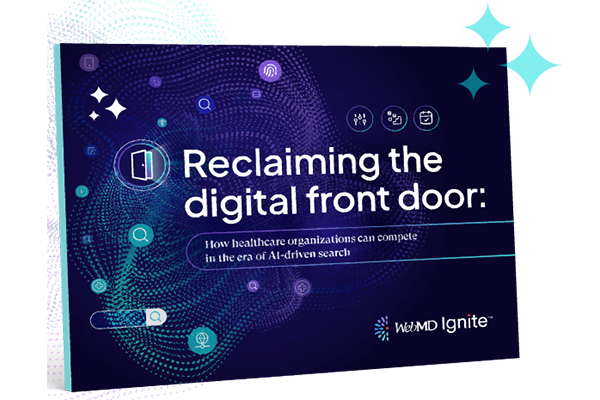5 Strategies to Drive Patient Retention

Categories: health systems, healthcare organizations
Tags: Build loyalty
Editor's Note: This blog was published prior to the transition to WebMD Ignite.
Patients have become discerning customers – they have plenty of healthcare options, and aren’t hesitant to shop around and compare healthcare networks on patient care, price, and overall experience. Furthermore, Millennial customers, who already outnumber the Baby Boomer generation, are more likely to proactively research cost information, medication coverage, and doctor quality ratings.1
With the ever-changing healthcare landscape, marketers must put a focus on patient retention in order to achieve significant growth for your health system. Attracting new patients is beneficial, but keeping them within your healthcare network has the potential for greater ROI.
Let’s take a closer look at five strategies to drive patient retention in the digital age:
1. Build strong relationships with multi-channel engagement
Each customer has a set of preferences on how, where, and when they want to engage with their health system. That’s why it’s essential for marketing teams to design multi-channel engagement campaigns so customers have the information they need to take the next step when and where they need it.
With a healthcare CRM, marketing teams leverage comprehensive customer profiles using customer and patient data to gain insights into communication preferences. With this information, customers receive more effective and proactive engagement from the provider.
Here are four steps to help you use multi-channel campaigns to build strong relationships and drive patient retention:
- Bring your data together—Consolidate your data to one location and begin to establish a central database for all customer and patient information. The use of software, such as a healthcare CRM, integrates data to provide consumers and patients with a seamless experience across channels.
- Find the right customers—Target patients who will find your campaign relevant to their healthcare needs. Leveraging a healthcare CRM and predictive and propensity modeling, healthcare marketers can employ precision marketing techniques to pinpoint the right patients to up-sell and cross-sell services.
- Use the right channels at the right time—When deciding how to engage patients throughout your campaign, consider patient preference and access to each channel (digital or otherwise). As the campaign runs, optimize accordingly.
- Leverage journey mapping—Patient journey maps are where it all comes together. They provide a roadmap for patient engagement and create positive patient experiences and foster loyalty. Patient journey mapping gives marketers the insight and understanding needed to elevate patient experiences at any stage in the journey by keeping consumers and patients engaged based on their needs and preferences.
2. Personalize interactions
As the healthcare market becomes more consumer-centric, healthcare organizations must work to personalize engagement efforts. Personalized interactions improve patient satisfaction, foster patient loyalty, and re-claim customers from competing healthcare networks.
When patient satisfaction improves, healthcare organizations often see fewer missed appointments, reduced readmissions, and more on-time payments, which all contribute to an increase in patient lifetime value.
Take a look at these three tactics to personalize interactions in your healthcare system:
- Make patient experiences simple & efficient—Consolidate any and all communications with patients and ensure a seamless experience across all channels. For each campaign, take advantage of the channels that your audience prefers and is likely to engage.
- Automate patient processes where you can to save them time before and after appointments. Maintain clear and consistent communication with all patients in your network.
- Quickly resolve inquiries—Prepare your healthcare call center agents so they can resolve issues quickly and drive patient retention. Develop a set of best practices that call center agents can use to resolve the most common inquiries. With guidelines for agents in place, they’ll be able to personalize call center interactions quickly and effectively.
- Use data-driven insights to provide actionable recommendations—Leverage your 360-degree patient views to understand where customers are on their healthcare journey and what exactly they need. Look into channels preferences, campaigns they relate to, and the in-network site of service most convenient to them. Use data insights from the call center, such as the average speed of answer, average hold time, and first call resolution rate, to determine where you’re lacking in your engagement efforts.
Let’s walk through an example:
An existing patient visits his primary care physician complaining of a nagging shoulder injury. The physician recommends physical therapy and gives a referral to sports medicine specialist. After one week, the patient hasn’t followed up to make the appointments, so a call center agent reaches out to the patient to encourage him to schedule the specialist appointment and help him find a physical therapy location near his office. As the patient waits for his appointment, he receives emails with relevant resources to help alleviate his shoulder pain.
3. Add convenience wherever you can
Consumers are accustomed to technology and now expect immediate, personalized healthcare at their fingertips. With 34% preferring retail clinics and 24% preferring acute care clinics, Millennial customers aren’t looking to primary care physicians as a first option.2
Also, Millennials are most likely to consider the availability of telemedicine options as extremely important. These insights show that convenience is a significant determining factor when Millennial patients consider their healthcare options.
Although it may seem impossible to live up to these expectations, there are steps you can take to make your patient experiences more convenient.
First, make sure all platforms are integrated and provide seamless online experiences. In today’s healthcare environment, many customers look for information online to help make a decision. Make sure any relevant information regarding costs, what to expect, or insurance is easily available on your website.
Next, take advantage of predictive analytics and machine learning to anticipate customer needs (and next steps) for better health outcomes. These technologies analyze data and provide insights for marketers to use to make more informed decisions more quickly.
Last, take advantage of virtual care and other new technology you can integrate into your health system. The presence of virtual care allows healthcare organizations to help patients anytime anywhere.
Let’s take a closer look at some examples of virtual health and other technologies that can add convenience to patient experiences:
- Telehealth: Physicians use a webcam and web hosting platform to provide virtual care to patients.
- mHealth: Mobile health apps provide patients with easily accessible healthcare information.
- Social media: Healthcare organizations can start broad discussions or respond to specific patient needs/inquiries.
- Wearable technology: Devices like the Fitbit and Apple Watch track patient health metrics, such as heart rate, and could be monitored in applicable patients (with their consent) to improve health outcomes.
4. Attain a higher standard of service
Providing better service may seem like the simplest way to retain customers, but in order to achieve it, cross-departmental cooperation and collaboration is necessary. Although it may seem the marketing team has little control over quality of service, there are things you can do to change your patients’ perception of the care they receive.
Use these three keys to improve the quality of service in your healthcare organization:
Transparency: Make patients feel like they have control over their healthcare by providing them with all information needed to make an informed decision. In addition to healthcare portals, consider creating content patients and customers can reference when they have a specific issue. Become a trusted resource for your patients beyond in-person visits.
Availability: From appointments to surgery, a healthcare organization should make sure patients can be seen in a timely manner. Marketing needs to be involved and aware of operational issues. For example, the marketing teams shouldn’t run a campaign for a service line that doesn’t have appointments available for months.
Hospitality: Go the extra mile for your patients whenever you can. Use a healthcare CRM-enabled engagement center to create positive patient experiences both in and out of the hospital. Simple actions like confirming appointments in advance, scheduling appointments in advance, and reaching out for over-due visits not only speed up processes but make patients feel good about your healthcare organization.
5. Seek customer feedback
The last – and maybe most important – strategy to retain customers is to listen. Administer patient feedback surveys to gain an understanding of how patients feel about your healthcare organization on a group and individual level.
Like any other piece of content, you’ll want to use the channels your patients prefer. This may mean reaching out through an email, a phone call, or even a direct mail piece. Analyze your results and look for trends. If you find a common issue, dig a little deeper and act on that feedback to resolve the situation.
For example, let’s say that an analysis by the marketing team reveals many patients are upset about waiting over three months for orthopedic surgery. As a result, patients are seeking other care options and the hospital is losing potential revenue. In coordination with the operational leaders, it’s determined that the service line is understaffed for the current market demand and there is a need for an additional surgeon to join the hospital.
Final thoughts
At the end of the day, patent retention is all about providing excellent service. Your marketing team should work in concert with healthcare providers to proactively engage patients and promote wellness.
Invest in tools and tactics that help make patients feel special and not just “one of many”. The more patients that you’re able to keep in your healthcare system, the greater the ROI and patient lifetime value.
Stay on top of your patients’ changing preferences, and make them want to stay. Learn more about how to deliver world-class patient experiences that improve patient loyalty and drive patient retention.
Sources
1.https://www.healthcareitnews.com/news/millennials-demand-telehealth-mov…
2.https://www.healthcareitnews.com/news/millennials-demand-telehealth-mov…




